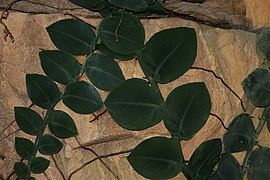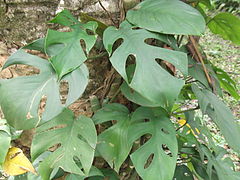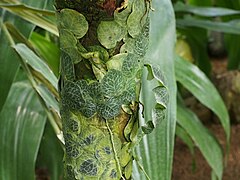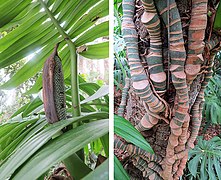
Cryptocoryne is a genus of aquatic plants from the family Araceae. The genus is naturally distributed in tropical regions of India, Southeast Asia and New Guinea.

Arisaema is a large and diverse genus of the flowering plant family Araceae. The largest concentration of species is in China and Japan, with other species native to other parts of southern Asia as well as eastern and central Africa, Mexico and eastern North America. Asiatic species are often called cobra lilies, while western species are often called jack-in-the-pulpit; both names refer to the distinctive appearance of the flower, which consists of an erect central spadix rising from a spathe.

Monstera is a genus of 59 species of flowering plants in the arum family, Araceae, native to tropical regions of the Americas.

Nephthytis is a genus of five species of flowering plants in the family Araceae, native to tropical western and west-central Africa, ranging from Guinea to the Republic of the Congo.
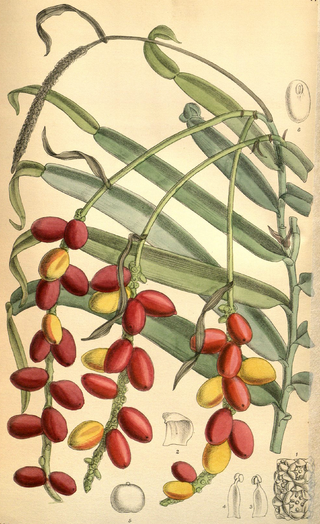
Pothos is a genus of flowering plants in the family Araceae. It is native to China, the Indian Subcontinent, Australia, New Guinea, Southeast Asia, and various islands of the Pacific and Indian Oceans.
Dischidia is a genus of plants in the “dog-bane” family Apocynaceae, collectively known as the “milkweeds”. They are epiphytes, native to tropical areas of China, India as well as Bhutan’s southern borders, wherever minimal frost occurs. Additionally, they are known from most areas of Mainland Southeast Asia, including forested areas of Myanmar, Thailand, Vietnam, Cambodia, Laos, and some parts of Indonesia, Malaysia and Singapore. Several species are also native to Papua New Guinea and northeastern Australia.

Epipremnum is a genus of flowering plants in the family Araceae, found in tropical forests from China, the Himalayas, and Southeast Asia to Australia the western Pacific. They are evergreen perennial vines climbing with the aid of aerial roots. They may be confused with other Monstereae such as Rhaphidophora, Scindapsus and Amydrium.

Schismatoglottis is a genus of flowering plants in the family Araceae. Members of the genus are similar in appearance and growth habit to those of the genus Homalomena, but the two genera are not closely related. The primary difference is that the leaves of Schismatoglottis are not aromatic. Schismatoglottis are found primarily in tropical parts of Southeast Asia, New Guinea, and Melanesia. The majority of the species are native to the Island of Borneo.

Biarum is a genus of flowering plants in the family Araceae. It is composed of plants that are native to the Middle East, southern Europe, and North Africa. Biarum are often found growing in rock crevices and graveled soil composed largely of limestone.

Aroideae is a subfamily of flowering plants in the family Araceae. It is the largest subfamily in Araceae and consists of about 72 different genera, and 2,300 species. Many Aroideae have spiny pollen grains without a sporopollenin outer exine layer and lacking an aperture.
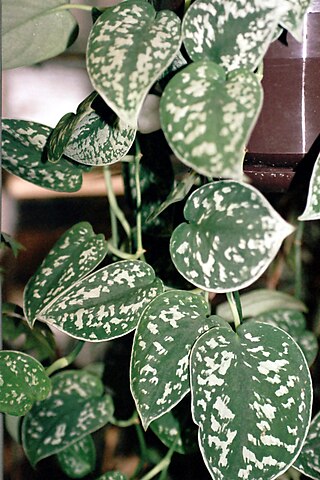
Scindapsus is a genus of flowering plants in the family Araceae. It is native to Southeast Asia, New Guinea, Queensland, and a few western Pacific islands. The species Scindapsus pictus is common in cultivation.
Alloschemone is a genus of evergreen root climbing plants in the family Araceae that is native to the Amazon region of Bolivia and Brazil. There are only two species in the genus and both are extremely rare. These two species are Alloschemone occidentalis and Alloschemone inopinata. At one point in history, the genus Alloschemone was dissolved and added to Scindapsus, but it has since been reinstated after further observations of the plants.
Anadendrum is a genus of flowering plants in the family Araceae. It is native to China and Southeast Asia.
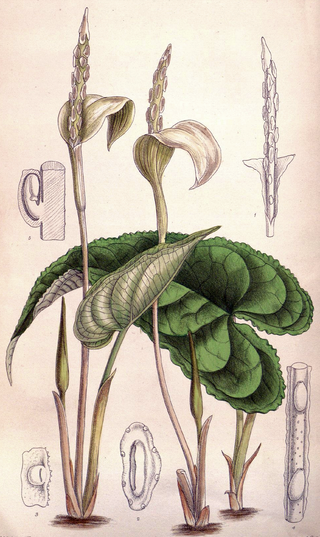
Hapaline is a genus of flowering plants in the family Araceae. It contains 7 species that are found from southern China to Borneo.

Rhaphidophora decursiva is a species of flowering plant in the family Araceae. It is native to China, the Indian Subcontinent, and Indochina.
Apoballis is a genus of plants in the Araceae. It is native to Southeast Asia, primarily the Island of Sumatra in Indonesia. Some authorities regard this group as part of the larger genus Schismatoglottis.
- Apoballis acuminatissima(Schott) S.Y.Wong & P.C.Boyce - Sumatra
- Apoballis belophylla(Alderw.) S.Y.Wong & P.C.Boyce - Sumatra
- Apoballis brevipes(Hook.f.) S.Y.Wong & P.C.Boyce - Sumatra, Thailand, Peninsular Malaysia
- Apoballis grandiflora(Alderw.) S.Y.Wong & P.C.Boyce - Sumatra
- Apoballis hastifolia(Hallier f. ex Engl.) S.Y.Wong & P.C.Boyce - Sumatra
- Apoballis javanica(Engl.) S.Y.Wong & P.C.Boyce - Java
- Apoballis longicaulis(Ridl.) S.Y.Wong & P.C.Boyce - Sumatra
- Apoballis mutata(Scort. ex Hook.f.) S.Y.Wong & P.C.Boyce - Myanmar, Sumatra, Thailand, Peninsular Malaysia
- Apoballis okadae(M.Hotta) S.Y.Wong & P.C.Boyce - Sumatra
- Apoballis ovata(Schott) S.Y.Wong & P.C.Boyce - Sumatra
- Apoballis rupestris(Zoll. & Moritzi) S.Y.Wong & P.C.Boyce - Sumatra, Java, Bali, Lombok, Timor
- Apoballis sagittifolia(Alderw.) S.Y.Wong & P.C.Boyce - Sumatra
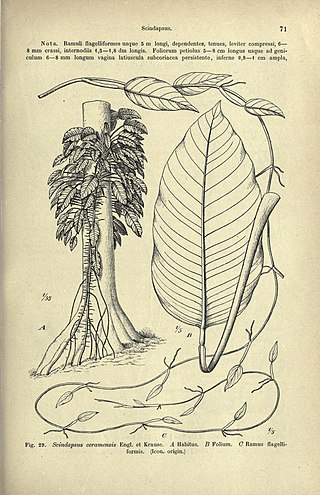
Epipremnum ceramense is a plant species of family Araceae. This type of woody vine is endemic in Maluku Islands' rainforest.
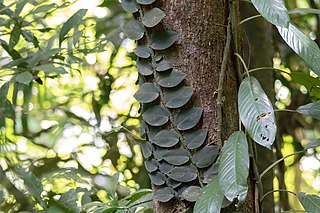
Rhaphidophora hayi is a species of flowering plant in the arum family Araceae, native to Queensland and New Guinea. It is an appressed or shingling semi-epiphytic vining plant that grows in wet tropical forests.

